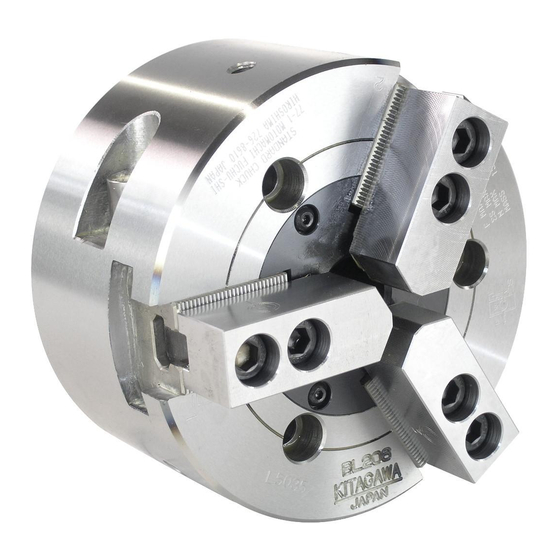
Table of Contents
Advertisement
Quick Links
INSTRUCTION MANUAL
BL200/BLT200
Large Thru-Hole Long Stroke Power Chuck
・This instruction manual is for production engineers and
maintenance personnel in charge of operation of this product.
When a beginner uses this product, receive instructions from
experienced personnel, the distributor or our company.
・Before installing, operating or maintaining this equipment,
carefully read this manual and the safety labels attached to
the equipment. Failure to follow these instructions and safety
precautions could result in serious injury, death, or property
damage.
・Store this manual near equipment for future reference.
・If any questions related to safety arise about this manual,
please confirm them with the distributor or our company.
Kitagawa Corporation
77-1,Motomachi,Fuchu-shi,Hiroshima,726-8610,Japan
Te l . +81-847-40-0561
Fax. +81-847-45-8911
Version 1.12 (2021.08.03)
Original instructions
type
Advertisement
Table of Contents

Summarization of Contents
Preface
Safety Message Symbols
Defines safety symbols like DANGER, WARNING, CAUTION, NOTICE used in the manual.
Manual Usage and Liability
Explains the manual's scope and company liability for misuse or non-adherence to instructions.
Guarantee and Liability Limits
Details the product guarantee period and limitations, emphasizing genuine parts.
Structural Drawing and Parts List
Model Type Display
Explains the coding system for model identification, including chuck nominal diameter and attachment shape.
Component Structural Drawing
Provides a visual representation of the chuck's components and their layout.
Product Scope Definition
Defines the parts of the hydraulic system covered by this manual, excluding the cylinder.
Detailed Parts List
Lists all components of the chuck with their corresponding part numbers and quantities.
Important Safety Precautions
General Operational Safety
Outlines critical safety rules for operating the chuck, including power off, door closure, and hydraulic pressure.
Speed, Force, and Compatibility Safety
Warns against exceeding maximum rotation speed and input force, and about chuck-cylinder compatibility.
Jaw Height, Work Support, and Draw Pipe Safety
Advises on jaw height limits, work support, and draw pipe integrity for safe operation.
Unbalanced Work and Bolt Tightening Safety
Stresses handling unbalanced work, proper bolt tightening, and compatibility for preventing failure.
Hydraulic System and Draw Pipe Integrity
Details draw pipe requirements and the need for a lock valve for hydraulic pressure stability.
Modification, Lubrication, and Personal Safety
Prohibits unauthorized modification, emphasizes greasing, and personal safety during operation.
Specifications
BL200 Series Specifications
Lists technical data like plunger stroke, jaw stroke, input force, gripping force, and rotation speed for BL200 series.
BLT200 Series Specifications
Lists technical data like plunger stroke, jaw stroke, input force, gripping force, and rotation speed for BLT200 series.
Gripping Force vs. Rotation Speed
Explains how rotation speed affects gripping force due to centrifugal forces and provides general guidelines.
Jaw Height and Mass Moment Effects on Grip
Details how jaw height and mass moment influence gripping force loss and requires careful consideration.
Forming Soft Jaw
Soft Jaw Attachment Procedures
Instructions on how to attach soft jaws, including bolt torque and T nut usage.
Forming for Outside Diameter Gripping
Step-by-step guide for forming soft jaws for outside diameter gripping using a plug.
Forming for Inside Diameter Gripping
Step-by-step guide for forming soft jaws for inside diameter gripping using a ring.
Forming Using a Jig
Instructions for forming soft jaws using a jig, detailing preparation, gripping, and forming steps.
Usage
Gripping Work Safety
Warns about hand safety when gripping work with the chuck.
Gripping Irregular Shapes Safely
Advises on gripping irregular shapes, potential master jaw breakage, and work support.
Proper Jaw Usage and Integrity
Warns against using non-genuine jaws, incorrect serration pitch, or welded jaws.
Precautions Related to Processing
Handling Workpiece Unbalance
Addresses issues related to unbalanced work, vibration, and cutting conditions.
Preventing Interference and Impact
Stresses checking for interference and avoiding impacts to prevent chuck damage.
Coolant's Role in Performance
Highlights the importance of coolant for rust prevention and maintaining gripping force.
Attaching Locators and Jigs
Guides on attaching locators and jigs, including drilling/tapping ranges and countermeasures for flying parts.
Maintenance and Inspection
Periodic Inspection Schedule
Outlines daily, monthly, and semi-annual checks for proper functioning and wear.
Grease Lubrication Procedures
Details procedures for lubricating the chuck, including grease type and frequency.
Chuck Disassembly and Cleaning
Provides step-by-step instructions for disassembling the chuck for cleaning or repair.
Malfunction and Countermeasures
Troubleshooting Common Malfunctions
A table listing common malfunctions, their causes, and corresponding countermeasures.
Attachment
Attachment Outline Diagram
A schematic showing the overall hydraulic and mechanical connections for attaching the chuck.
Back Plate Manufacturing
Specifies dimensions and tolerances for manufacturing a custom draw pipe and back plate.
Chuck Attachment Procedures
Guides on attaching the draw pipe, cylinder, and chuck, including adjustments and checks.
Other Information
Applicable Standards and Regulations
Lists relevant standards and directives applicable to the product.
Product Markings Identification
Explains the meaning of various markings and labels found on the chuck.
Product Disposal Guidelines
Provides guidance on the environmentally responsible disposal of the product.
















Need help?
Do you have a question about the BL210 and is the answer not in the manual?
Questions and answers